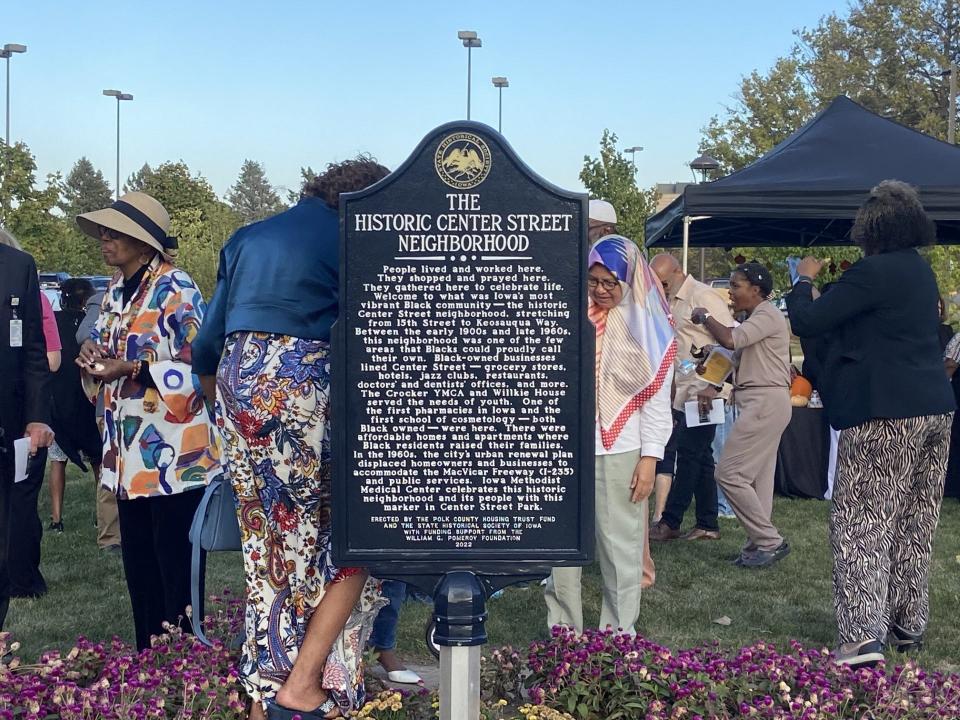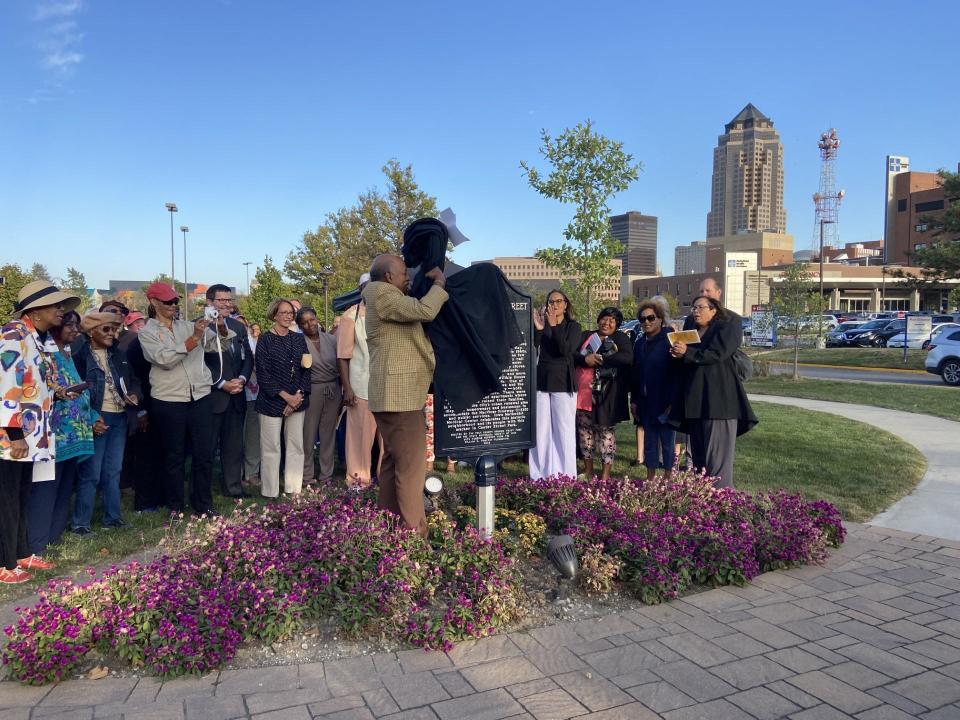Center Street neighborhood, once a hub of Black culture in Des Moines, gets historic marker
A historical marker now sits at the site of what was once Iowa's most vibrant Black community.
The historic Center Street neighborhood, stretching from 15th Street to Keosauqua Way, was once filled with thriving Black-owned businesses like grocery stores, hotels, jazz clubs, restaurants, doctors’ and dentists’ offices. It was cleared out to make way for Interstate 235 and urban renewal.
The marker was unveiled at Center Street Park, on the north side of the Iowa Methodist Medical Center campus, 1200 Pleasant St., on Thursday.

Today, the I-235 freeway runs through the heart of Des Moines, and the Iowa Methodist Medical Center stands where the Center Street neighborhood once thrived. But that's a lot different than how Des Moines used to look.
The Center Street neighborhood was a core area of Black culture in Iowa, where, prior to the 1950s, it was full of barber shops, restaurants, grocery stores, pharmacies, hotels and laundromats. Everything needed to flourish was right there in Center Street.
Richard Duncan, a former resident who once lived on Center Street, recalled what it was like to grow up in the once flourishing community.
“I have enough stuff in my head that I could sit here and talk most of the day about people, places and things around Center Street,” Duncan said.
More: Redlining: How racist policy from a 1930s program has left scars still visible in today's Des Moines
Post-World War II, cities across the nation fell in an economically-fueled downward spiral, sparking the first broad program of land redevelopment and improvement, a process known as urban renewal, changing the lives of those like Duncan.
Urban renewal efforts nationwide were initiated by Congress in the Housing Act of 1949, to start the process of redevelopment as well as the promotion of mortgage lending, but also directed banks to not make loans in neighborhoods labeled as “risky."
Ultimately, the act’s purpose ended up being to eliminate undesirable neighborhoods, which were defined by the redlining process.
“I don’t call it urban renewal, I call it urban removal because this community was removed,” said Iowa state Rep. Ako Abdul-Samad.
According to the American Planning Association, the act “aimed at reducing housing costs, raising housing standards, and enabling the federal government for the first time, to aid cities in clearing slums and rebuilding blighted areas.”
In Des Moines, the process of urban renewal looked like the demolition of the Black hub that the Center Street neighborhood, and more, once were. The neighborhood, once full of culture, fell to the bulldozing efforts of the $60 million paving project of I-235, which began in the late 1950s.

When construction started, it displaced about 1,300 families and business that resided in the district between 10th and 14th streets.
Construction of the 14-mile freeway wrapped up in October of 1968.
Now, over 60 years after the I-235 project began, the losses the Black community of Des Moines faced during urban renewal are being recognized.
“There are a lot of people that don’t understand what happened to Center Street,” said Jay Singleton, board member of the Polk County Housing Trust Fund. “There’s a lot of African Americans who don’t understand it. There’s a lot of native Iowans who don’t understand it.”
The inscription of the historical marker tells the story of Center Street and what it meant to the Black community while it still stood, and what it means today:
“People lived and worked here. They shopped and prayed here. They gathered here to celebrate life. Welcome to what was Iowa’s most vibrant Black community – The historic Center Street neighborhood, stretching from 15th Street to Keosauqua Way. Between the early 1900s and 1960s, this neighborhood was one of the few areas the Blacks could proudly call their own. Black-owned businesses lined Center Street – grocery stores, hotels, jazz clubs, restaurants, doctors’ and dentists’ offices and more. The Crocker YMCA and Willkie House served the needs of youth. One of the first pharmacies in Iowa and the first school of cosmetology – both Black owned – were here. There were affordable homes and apartments where Black residents raised their families. In the 1960s, the city’s urban renewal plan displaced homeowners and businesses to accommodate the MacVicar Freeway (I-235) and public services. Iowa Methodist Medical Center celebrates this historic neighborhood and its people with this marker in Center Street Park.”
Kyle Werner is an intern at the Des Moines Register. Reach him at kwerner@dmreg.com.
This article originally appeared on Des Moines Register: Des Moines Black-owned Center Street neighborhood gets historic marker

